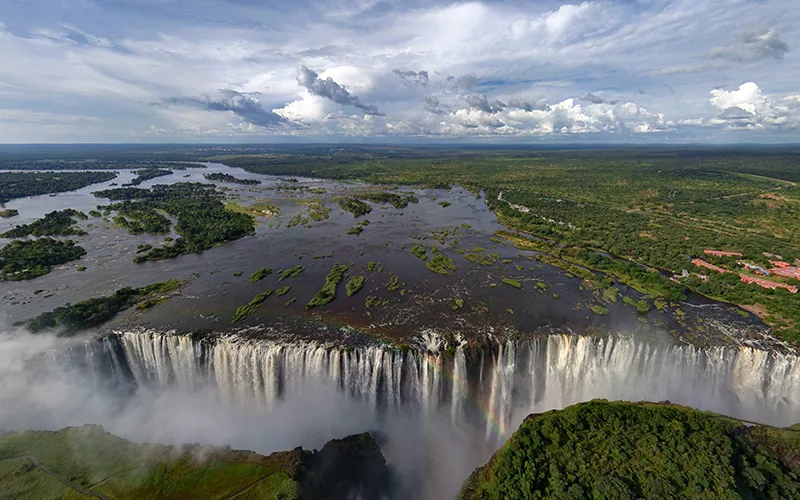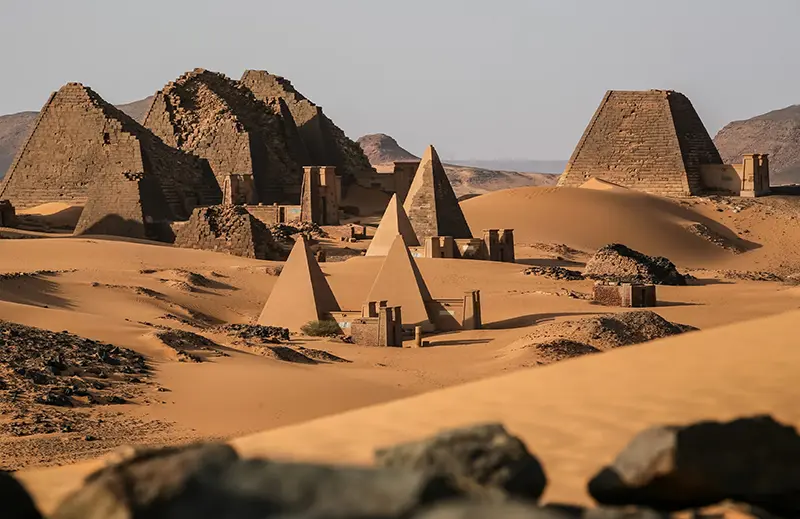History
The ancient Greek legends and poems of Homer (between the twelfth and seventh centuries B.C.) tell the story of the great titan Atlas. He was believed to live in the far west, which the Greeks at the time might have thought to be the African coast, and to have great strength – enough to support the pillars that separate the firmament from the earth (which is how our remote ancestors imagined the place and appearance of the earth in space). It was associated with the ocean, and was considered a sea titan treacherous and unruly. But there was a help for him too: Atlas, who in some legends was also called the African king, had the carelessness to refuse hospitality to the legendary Greek hero Perseus. And Perseus at that time was already in possession of the magical head of Gorgon Medusa, which turned anyone who looked at it into stone. Annoyed at the conduct of Atlas, Perseus showed the titan the ill-fated head of Medusa and turned him into the African mountain Atlas. Myths are myths, but in the northwest of Africa, where Atlas would have lived, there is a long mountain range, the Atlas Mountains.
Under this name they are known in Europe, but the local population does not have a single name – only the names of individual ranges. These mountains cross the territory of Morocco, Algeria and Tunisia and consist of several ranges: Tell Atlas (High Atlas), Middle Atlas and Sahara Atlas. In between are the plains and several interior plateaus – the High, the Oran-Algerian, and the Moroccan Meseta. The latter, from the most elevated part of the Rif Range, terraces down to the west.
Atlas is a whole mountainous country. It stretches from the shores of the Atlantic Ocean, crossing the African continent from west to east, almost along the coast of the Mediterranean Sea (Tell-Atlas Ridge). It is so long that it alternates between tropical and subtropical belts, providing very contrasting landscapes: mountains and traces of ancient glaciation on their highest peaks, blooming oases, desert (Sahara Ridge), rivers and sebhas (salt lakes).
In the north and west, vegetation up to altitudes of 800 m is similar to the usual forests typical of the Mediterranean: picturesque thickets of evergreen shrubs and cork oak reminiscent of southern Europe. The south and interior are characterized by an arid climate, so that cereals, feather grasses, and sagebrush mainly survive here. Higher belts are formed by evergreen forests of cork and stone oak (up to 1200 m), higher (up to 1700 m) they are joined by maples and conifers. Even higher (above 2200 m), these forests are replaced by coniferous forests dominated by a valuable, drought-resistant and pest-resistant species of structural wood – the Atlas cedar, which since 1842 began to be cultivated in Europe and for decorative purposes.
The Atlas country is separated from the African tectonic plate by a fault in its southern part (the South Atlas Fault).
Another fault runs along the Mediterranean coast, and it is this fault that provokes earthquakes in this part of the range.
The Atlas was formed in three phases. The first phase of deformation (in the Paleozoic) affected only the Antiatlas as a result of the collision of continents. The second phase during the Mesozoic formed most of the modern High Atlas, then it rested on the ocean floor. In the Tertiary period, the Atlas appeared on the surface.
The mountains developed deposits of iron ores and copper, iron and lead, lime, rock salt, and marble.
The rugged mountains with their capricious climate are not an uninhabited region: there are rivers (especially in the northwest) along which settlements have long been formed. The local rivers, fed by rainwater and often of a “temporary” nature, are called by the Arabs Ouedes. They even have floods in winter, but in summer they almost completely dry up, especially in the southern and interior areas.
To live in such conditions have adapted Berbers (indigenous peoples of North Africa), who have survived all the historical vicissitudes of the region and have remained steadfast inhabitants of the unfriendly mountains. There are differences between them in both language and way of life. The Berbers of the western Atlas Mountains are called Shillukh. They are more sedentary, live in houses, engage in agriculture, and are successful in a number of crafts. Their villages are often scattered far apart.
Farming requires a Herculean effort, because you first have to create your own land. There is often no soil on the rocky, weathered slopes of the mountains, so prospective farmers look for places in the hollows where soil has washed or drifted, and from there they carry it in baskets on their heads to their plots. The precious soil is laid in special terraces that are hollowed out in the rocks. This earth then has to be watched to make sure it doesn’t get washed away by the rain. The plots can be so small that it is impossible to till them with a plough and one has to do everything by hand.
The inhabitants of such villages are also engaged in sheep breeding. And their neighbors from the eastern part of the mountains, the Masigs still live in caves and tents, which is apparently more convenient for their active movements. You can go up to the higher valleys where the grass is more lush. Some Berber tribes are solely cattle herders, but they have permanent villages to which they return after grazing in the mountains, where they live in makeshift camps.
The Berbers represent mainly the Moroccan part of the inhabitants of the mountains. On the Algerian side, they were also mastered by the Kabyle (a local Berber species). Recently, people have noticeably affected the landscape – in the north, closer to the coast, there is less natural vegetation, the area of artificially irrigated land has increased, where they grow citrus, cereals, cultivate olive and eucalyptus trees, date palms. And peach and apricot orchards, pomegranate plantations and vineyards can now also be seen near private buildings. These interventions in the ecosystem have even given rise to a number of problems: for example, the removal of forests has led to soil erosion in places.
The existence of these mountains was already spoken of by the Phoenicians and later by the ancient Greeks who traveled extensively around the world. And the Romans – in 42, the Roman commander Gaius Suetonius Paulinus (I century) crossed the mountains. And in the II century, the Greek itinerant philosopher, orator, and writer Maximus of Tyre had already made a sufficiently detailed description of the mountains for that time.
But the world scientific community could significantly expand its understanding of this mountainous country only by the 19th century, when the outstanding German explorer of Africa Gerhard Rolfe (1831-1896) crossed the High Atlas under the guise of a Muslim in the service of the Moroccan sultan, studied the largest oases and went deeper into the Sahara from the Algerian side. It was he who significantly refined the map of the ranges and created two books from descriptions of his routes and impressions.
Tourists began to follow the explorers here, attracted by the sunrises and sunsets in the mountains, beautiful views, many migratory birds, mountain oases (like Shebik in Tunisia), pockets of life in the desert (like the Sauf oasis group in Algeria), date oases in Morocco and the palace of Marrakech Pasha Thami el Glaoui.
General Information
- Countries: Morocco, Algeria, Tunisia.
- Salt lakes: Chottes-el-Sherghi.
- Major rivers: Umm-er-Rbia, Cebu (Atlantic Ocean basin), Muluya, Sheliff (Mediterranean Sea basin).
- Major airports: Houari Boumediene International Airport (Algiers, Algeria), Mohammed V International Airport (Casablanca, Algeria), and the Caspian Sea International Airport (Algiers, Algeria). Mohammed V International Airport (Casablanca, Morocco).
- Length: 2,400 km.
- Highest point: Mount Toubkal (4167 m, Morocco).
Economy
- Minerals: silver, copper, iron, lead, mercury, gas, coal, marble, rock salt.
- Agriculture: plant growing, animal breeding.
- Services: tourism.
Climate and weather
- Subtropical, Mediterranean in the north, semi-desert in other parts.
- Average January temperature: +12°C (up to 1,500 m – lower mountain zone, northern part), +6°C (inland areas).
- Average July temperature: +25°C (up to 1,500 m), +38°C (in the interior plains).
- The average annual rainfall is up to 600 mm (main part), up to 1800 mm (Tell-Atlas, north and west), up to 2500 mm (High Atlas), 300 mm (southern part).
- At night, there are often frosts.
Attractions
- Oases: Chebika (Tunisia), the oasis group Sauf (Algeria).
- Morocco: the city of Marrakesh and the palace of Dar el-Glaoui (early 20th century), residence of the Pasha Thame el-Glaoui, the oasis town of Tafraoute.
- Algeria: the city of Timgad, ruins of the Roman era, the Djuradjoura National Park, Lake Sidi Bel Abbes.
- Tunisia: Salt Lakes.
Fun Facts
- Normally monkeys (macaques) settle in temperate latitudes and prefer Asia. But in the Atlas Mountains there is only one species that not only lives in this difficult climate, but is also the only monkey species living naturally in the south of Europe (in Gibraltar) – it is the magots, the Barbary monkeys, or Berberian (Maghreb) monkeys. And the region of the Atlas Mountains is considered their homeland. One version even assumes that the species previously inhabited different regions of Europe, and the colony in Gibraltar is simply the only thing left. Magoths have remarkable habits. For example, males can choose a favorite among not only their own, but also other people’s cubs, and then they will be groomed in every way and proudly show them to their mates. Also cubs are shown to enemies – in Magothy this diplomatic technique is able to reduce the aggression of the enemy.
- The oil of Atlas cedar is an excellent antiseptic and a means of breaking down fat. It has long been used for medicinal purposes, to make mummifying balms and is still used in cosmetology and perfumery.
- The local wild cereal called alpha can be used to make high-grade paper: its fibers yield so-called “false horsehair”, suitable even for weaving. In some places, they try to grow it on purpose.
- The prominent British politician Winston Churchill is not much known as an artist as well: His only painting during the Second World War is believed to have been painted in 1943 during his meeting with American President Theodore Roosevelt in Casablanca watching the sun set over the Atlas Mountains from that Moroccan city.
- Even in the hottest heat, reaching up to +40 ° C, locals can be seen wearing warm jackets and knitted hats with a piece of cardboard instead of a visor In a hot and dry climate warm clothing is just as useful as in the cold.
- There may have been a bear in North Africa up until the end of the 19th century. The Atlas brown bear lived in the range of the Atlas Mountains and areas that are now part of the Sahara Desert, as fossil remains testify.
- One of the villages in the Atlas Mountains was the site of the first film set of Prince of Persia: The Sands of Time. The actors had to acclimatize to film at an altitude of more than 4,000 meters.
- The Atlas Mountains are home to an amazing butterfly, the peacock-eyed atlas, which can have a wingspan of up to 30 cm, making it sometimes mistaken for a bird from afar. It frightens off its enemies by its specific coloration: the edge of its front wing is curved and painted in such a way that it resembles a snake’s head.
- For hundreds of years the Berbers of the Atlas Mountains have used a local breed of dog, the Atlas Shepherd, or Aidi, to help them graze their cattle and protect their personal property. These human helpers are called differently in different parts of the country: aidi in Morocco, Kabyle dogs and shaouya in Algeria.




